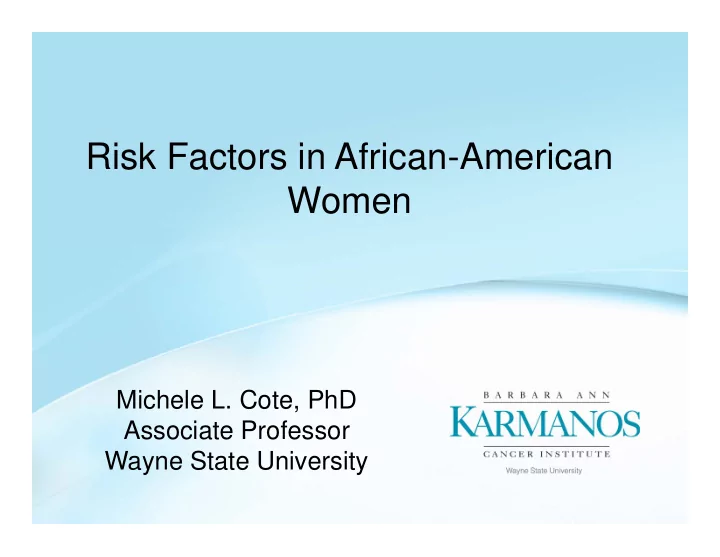

Risk Factors in African-American Women Michele L. Cote, PhD Associate Professor W Wayne State University St t U i it
Age Adjusted Incidence and Mortality Rates for all Endometrial Cancers 2000-2010 by Race/Ethnicity for SEER 18 Surveillance, Epidemiology, and End Results (SEER) Program (www.seer.cancer.gov) SEER*Stat Database: Incidence - SEER 18 Regs Research Data + Hurricane Katrina Impacted Louisiana Cases, Nov 2012 Sub (2000-2010) <Katrina/Rita Population Adjustment> - Linked To County Attributes - Total U.S., 1969-2011 Counties, National Cancer Institute, DCCPS, Surveillance Research Program, Surveillance Systems Branch, released April 2013, based on the November 2012 submission.
Endometrial Cancer—large survival disparity disparity
Age Adjusted Incidence and Mortality Rates for Endometrioid and Serous Endometrial Cancer 2000-2010 by Race/Ethnicity for SEER 18 Endometrioid Endometrioid Serous Serous 25 5 Incidence Incidence Mortality y Mortality y 20 4 te per 100,000 te per 100,000 15 3 Age Adjusted Rat Age Adjusted Rat 10 2 A A 5 1 0 0 NHW NHB Hispanic p Asian NHW NHB Hispanic p Asian Surveillance, Epidemiology, and End Results (SEER) Program (www.seer.cancer.gov) SEER*Stat Database: Incidence - SEER 18 Regs Research Data + Hurricane Katrina Impacted Louisiana Cases, Nov 2012 Sub (2000-2010) <Katrina/Rita Population Adjustment> - Linked To County Attributes - Total U.S., 1969-2011 Counties, National Cancer Institute, DCCPS, Surveillance Research Program, Surveillance Systems Branch, released April 2013, based on the November 2012 submission.
Age Adjusted Incidence Rates for Endometrioid and Serous Endometrial Cancer, 2000-2010 by , y race/ethnicity and year, SEER 18 Endometrioid Endometrioid Serous Serous APC =0.4 APC = 3.1* APC = 1.9* APC = 1.3* APC = 1.9* APC 1 9* APC APC = 10.3* 10 3* APC = 2.6* APC = 3.1 Surveillance, Epidemiology, and End Results (SEER) Program (www.seer.cancer.gov) SEER*Stat Database: Incidence - SEER 18 Regs Research Data + Hurricane Katrina Impacted Louisiana Cases, Nov 2012 Sub (2000-2010) <Katrina/Rita Population Adjustment> - Linked To County Attributes - Total U.S., 1969-2011 Counties, National Cancer Institute, DCCPS, Surveillance Research Program, Surveillance Systems Branch, released April 2013, based on the November 2012 submission.
Relative 5-year Survival Rates for Endometrioid and Serous Endometrial Cancer by Race/Ethnicity y / y 2000-2005, SEER 18 Endometrioid Endometrioid Serous Serous 100% 100% NHW NHW 90% 90% NHB NHB NHB NHB 80% 80% Hispanic Hispanic 70% 70% Asian Asian urvival urvival 60% 60% Relative Su Relative Su 50% 50% 40% 40% 30% 30% 20% 20% 10% 10% 0% 0% Local Regional g Distant Local Regional g Distant Surveillance, Epidemiology, and End Results (SEER) Program (www.seer.cancer.gov) SEER*Stat Database: Incidence - SEER 18 Regs Research Data + Hurricane Katrina Impacted Louisiana Cases, Nov 2012 Sub (2000-2010) <Katrina/Rita Population Adjustment> - Linked To County Attributes - Total U.S., 1969-2011 Counties, National Cancer Institute, DCCPS, Surveillance Research Program, Surveillance Systems Branch, released April 2013, based on the November 2012 submission.
Hysterectomy common in US women Jamison PM et al. 2013. “Trends in endometrial cancer incidence by race and histology with a correction for the prevalence of hysterectomy, SEER 1992 to 2008”. Cancer Epi Biomarkers and Prev; 22(2) pgs 233-241
Correcting for hysterectomy, ages 50+ •Without correction for hysterectomy rates •Without correction for hysterectomy, rates in black women are increasing and nearly equal to white women •With correction, rates in black women are increasing and exceed the rate in white women women Jamison PM et al. 2013
Background Summary •Endometrial cancer incidence is increasing among African Americans •Increases seen for both endometrioid and serous sub- Increases seen for both endometrioid and serous sub types •The survival disparity remains unchanged •The survival disparity remains unchanged Question: Do endometrial cancer risk factors or effect sizes differ between black and white women? between black and white women?
Studies complied through E2C2 Pooled analysis: 11 studies Black women n cases =516/n controls =1 495 Black women n cases 516/n controls 1,495 White women: n cases =5,693/n controls =13,604 Cohort: Black Cases AARP AARP 81 81 California Teachers Study 12 Multiethnic Cohort Study 128 New York University Women’s Health Study y y 23 PLCO 23 Southern Community Cohort Study 32 Women’s Health Initiative Study 53 Case-control: Bay Area Women’s Health Study 44 Estrogen, Diet, Genetics and Endometrial Cancer Study g y 39 Fred Hutchinson Cancer Research Center Study 14 Women’s Insight and Shared Experience Study 67
Associations for common risk factors similar for white and black women i il f hit d bl k Models adjusted for: age, BMI, smoking status, OC use, diabetes, age at *statistically significant at p<0.05 menarche, parity
Other risk factors Oral Contraceptives White Black 0<1 year 0 1 ref f ref f 1-4 years 1.03 (0.88, 1.20) 0.59 (0.37, 0.97) 5-9 years 0.95 (0.80, 1.13) 0.74 (0.42, 1.29) 10+ years y 0.69 (0.58, 0.83) ( , ) 0.49 (0.27, 0.88) ( , ) p-trend <0.001 0.04 Hypertension White Black No ref ref Yes 0.88 (0.66, 1.17) 0.99 (0.90, 1.08)
Limitations •Even with 11 large studies, power was limited when g , p examining risk in black women unable to examine histological subtypes by race •Data harmonization, particularly of hormone use, is challenging g g could not assess sequential versus continuous HT •Most common variables between studies were those for estrogen-dependent cancers already fairly well characterized already fairly well-characterized
Could survival differences be due to underlying tumor biology? underlying tumor biology? Study: 150 tumors from white (n=66) and African American (n=84) women
Cote ML, et al. (2012) Int J Gyn Cancer, 22(8)
Conclusions •Incidence of endometrial cancer is increasing among black women in the U.S. the U.S. •Survivorship hasn’t improved dramatically over the last 3 decades— and still worse for black women at every stage •The effect sizes for established endometrial cancer risk factors are similar among black and white women •We lack the power to adequately assess risk among black women, We lack the power to adequately assess risk among black women need to consider histological type •Elucidating molecular differences may provide clues to treatment, survival
Thank you! Special thanks to Julie Ruterbusch for the current SEER analyses
Recommend
More recommend